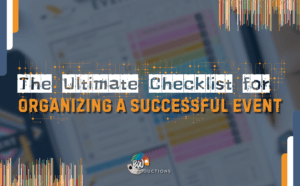Writing an event template can feel like navigating a maze, unsure of which turn to take first. An interesting fact is that a well-crafted event template streamlines planning from start to finish.
This article will guide you through creating your own, ensuring no detail is overlooked and making the process as smooth as possible. Let’s dive in.
Key Takeaways
- Identify clear goals for your event to guide every decision you make. This helps in creating events that have a strong impact and meet your objectives.
- Set up a budget early on, considering all potential expenses. Use this to keep track of spending and ensure you stay within financial limits.
- Map out a detailed timeline for planning the event. Include key milestones and deadlines to keep everything organised.
- In your proposal, include an engaging description of the event, list services offered, showcase previous work successfully completed, propose costs clearly, and outline any relevant policies.
- Apply best practices like crafting a compelling narrative about your event, writing with the target audience in mind, emphasising unique values of the event, being transparent about the budget and costs involved.
Understanding an Event Template

An event template provides a clear outline for organising an event. It covers everything from the initial concept to staffing requirements. This general guide helps in crafting a comprehensive proposal unique to each event’s needs.
It streamlines the planning process, making it easier to manage budgets, venue selection, and schedule management.
Using an event template ensures critical details are not missed. It aids in compiling vital resources and articulating the purpose of the event effectively. This tool is indispensable for gathering all necessary information before beginning the actual planning phase.
Event templates serve as a map, guiding through research processes and outlining important steps towards creating a successful event brief.
Steps to Create an Event Template

Identify the goals for the event. Establish a budget and set a timeline.
Identify the Goals for the Event
First, pinpointing the goals for the event is crucial—it’s where every successful gathering begins. These objectives shine a light on what you aim to achieve during and after your function.
Whether it’s increasing brand awareness, boosting sales, or fostering community engagement, defining these targets early guides every decision that follows. It ensures all elements of the event are aligned with your vision and mission.
Clear articulation of these aims sets a measurable benchmark for event success. It enables planners to tailor strategies that resonate with their intended audience effectively—creating impactful events that linger in attendees’ memories long after they’ve concluded.
This careful planning not only ensures the event’s purpose is fulfilled but also enhances its overall impact on participants and stakeholders alike.
Establish a Budget
Creating a budgetfinancial parametersLook into past events and industry research to set realistic numbers. Consider all possible expenses, including those unexpected ones, ensuring everything stays within financial boundaries.
Next, develop a detailed event budget template. This tool helps track spending against the planned budget, making it easier to manage costs effectively. Use expense tracking and financial forecasting to adjust plans as needed, keeping your event on solid fiscal ground without sacrificing quality or impact.
Set a Timeline
Marking out a timeline is crucial in the planning phase. You need to chart every key milestone from start to finish. This ensures every part of the event, down to the minute details, has a specific time allocated.
With over 40 customisable timeline templates available, you’ve got plenty of options to visualise your event schedule effectively.
Decide on deadlines early and stick to them. This involves picking dates for venue booking, vendor contracts, and final rehearsals. Using an event scheduling tool can drastically reduce stress by keeping everything organised and visible at a glance.
Remember, a well-structured timeline keeps your team synchronised and makes sure nothing falls through the cracks.
Key Components of an Event Proposal
Attract attendees with a captivating event description, showcase services offered, display previous work, propose costs, and outline event policies. Read on to master the art of creating an irresistible event proposal..
Engaging Event Description
Crafting an engaging event description involves highlighting distinctive features to set your event apart. Start with a concise overview that captures the essence of your event concept and objectives.
Ensure you include relevant details such as the date, time, venue, ticket fees, and activities planned. This approach not only informs but also excites potential attendees about what makes your event unique.
Incorporate clear objectives and relevant details throughout your description. Mention the unique selling points early on to grab attention quickly. Keep language simple yet vivid to paint a picture in the reader’s mind – imagine taking them by the hand and walking them through what they can expect.
It’s all about creating anticipation while providing all necessary information like event date, time, venue, and ticket costs upfront.
List of Services Offered
Creating an event template is like building a roadmap for your event. It ensures every aspect is covered, from start to finish. Let’s dive into the list of services offered that form the backbone of any solid event proposal.
- Venue Selection – This service involves finding the perfect location that matches the theme and size of your event. It includes considering factors such as space capacity, location, accessibility, and parking availability.
- Catering Options – Food and drink are central to any event experience. This service covers menu planning, food preparation, serving, and even post-event cleanup. Providers work closely with clients to accommodate dietary restrictions and preferences.
- Decor and Setup – Transforming a space to fit your vision comes under this service. From table arrangements to lighting and props, every detail is tailored to create the desired ambiance.
- Entertainment Booking – Whether it’s a DJ, band, or solo artist, securing the right entertainment can make or break an event. This service includes negotiations on behalf of the client to ensure both budget compatibility and performance expectations are met.
- Audio – Visual Equipment – Essential for nearly any type of event; this service covers the provision of microphones, speakers, projectors, screens, and more. It often includes technical support throughout the event.
- Security Services – Ensuring guests’ safety is paramount; hence this service provides trained security personnel who manage access control, crowd management, and emergency response strategies.
- Transportation and Accommodation – For events with out-of-town guests or in remote locations, arranging travel and lodging becomes necessary. This service includes booking hotels at group rates and organising transport logistics.
- Marketing Support – Getting the word out about your event could involve social media promotion, print materials design (like brochures or banners), and email marketing campaigns.
Showcase of Previous Work
Showcasing previous work in an event proposal impresses potential clients. It highlights expertise and the team’s ability to organise successful events. Here are key elements to include:
- Portfolio of past events: Present a carefully selected range of past events that demonstrate versatility and capability in handling various types of gatherings, from intimate corporate meetings to large-scale public festivals. This allows clients to visually assess the quality and creativity of your work.
- Detailed case studies: For each showcased event, provide brief yet comprehensive case studies. Discuss challenges faced, solutions implemented, and outcomes achieved. This demonstrates problem-solving skills and adaptability.
- Testimonials from satisfied clients: Include quotes or feedback from previous clients praising your professionalism, attention to detail, and overall management skills. Positive reviews build trust with potential new clients.
- Awards and recognitions: If your work has received awards or notable recognition within the event planning industry, make sure to highlight these achievements. They serve as proof of excellence and a commitment to high standards.
- Media mentions: Feature any coverage your events have received in magazines, online publications, or television. Media mentions not only lend credibility but also show that your events have made an impact worth talking about.
- Before-and-after visuals: Provide photos or videos showing the transformation of spaces for events. This showcases creative vision and execution capabilities, illustrating the dramatic changes you can make.
- List of services offered: Clearly outline all services you can provide, connecting them directly with examples from your portfolio where those services were applied successfully. This helps clients understand the full range of your capabilities.
Proposed Costs
Understanding the economic landscape of any event is crucial—a fact that cannot be understated. The proposed costs outlined within an event template serve as a clear, transparent indication of what the client or stakeholder can anticipate in terms of financial commitment. This segment is especially vital in illuminating the quality and pricing of additional vendors, which is essential for making informed decisions. Below, we delve into an illustrative example of how proposed costs can be structured within an event proposal:
| Cost Item | Description | Estimated Cost |
|---|---|---|
| Venue Hire | Rental cost for event location | $2,000 |
| Catering | Food and beverage for guests | $1,500 |
| Entertainment | Music, DJ, or live performances | $800 |
| Decoration | Theme-based decor | $600 |
| Marketing | Promotion of the event | $500 |
| Technology | Audio-visual equipment rental | $400 |
| Staffing | Event staff, security, coordinators | $700 |
| Contingency Fund | Unexpected expenses | $500 |
| Total | $7,000 |
In crafting an event proposal, including a detailed breakdown of proposed costs not only showcases transparency but also aligns expectations between the event planner and the client. This practice facilitates a smooth planning process, enabling both parties to manage finances effectively and ensure the event’s economic viability. Through this detailed example, one can appreciate the clarity and foresight that a well-prepared event proposal can provide, ultimately underscoring the significance of anticipated expenses in the realm of event planning.
Event Policies
Ensure event policies are clear, concise, and prominently featured in the proposal to protect both the client and your business. Include detailed cancellation terms, rental/damage policy, and payment due dates to avoid future disputes or misunderstandings.
By addressing these policies upfront, you establish transparency and trust with your clients while safeguarding your interests.
Craft event policies that outline cancellation terms, rental/damage policy, and payment due dates to prevent potential conflicts down the line. This level of clarity not only assures clients but also protects your business from any unforeseen issues.
Best Practices for Writing an Event Proposal
Craft a compelling narrative that resonates with your audience, showcases your unique offerings, and communicates the value of your event proposal. Dive deeper into these best practices by reading more on our blog.
Telling a Compelling Story
Crafting a compelling event proposal involves showcasing the brand’s strengths, achievements, and values. Emphasising these unique selling points in a narrative format can engage and captivate the audience.
By highlighting expertise and previous successes, an event proposal can tell a persuasive story that resonates with potential clients. This approach not only communicates the brand’s capabilities but also establishes a connection with the target audience to make the proposal more appealing and effective.
Being Attractive and Informative
Craft a compelling event proposal by showcasing your brand’s strengths, achievements, and values to capture the audience’s attention. Emphasise transparency about the budget to build trust with your potential clients.
Craft a narrative that tells an engaging story, resonates with the target audience, and emphasises unique value propositions.
Highlight your commitment to excellence in assisting customers in achieving their event objectives. Engage the audience through captivating descriptions of services offered and previous successful events while being transparent about proposed costs and event policies.
Writing for the Target Audience
Understand your audience demographics and preferences to tailor the event proposal effectively. Customising the content for the target audience increases engagement and resonates with their interests.
Addressing their needs in a transparent and compelling manner is crucial for an impactful event proposal. Emphasise the unique values that align with the audience’s interests while maintaining transparency about the budget to build trust.
Crafting an event proposal involves analysing and understanding your target audience, tailoring every aspect of the proposal to captivate their attention. By identifying their needs, preferences, and concerns, you can create a persuasive narrative that will resonate with them effectively.
Emphasising Unique Values
Highlight the event’s unparalleled characteristics to make it stand out. Bring attention to the distinctive strengths and exclusive offerings of the event, showcasing its standout elements and one-of-a-kind aspects.
Elevate the unique selling points and spotlight exceptional features to create a compelling case in the proposal.
Promote the event’s distinctive values by accentuating special attributes and showcasing its standout strengths. Emphasise the brand’s achievements, strengths, and values to differentiate it from others, ensuring transparency about its budget while telling a compelling story that resonates with the target audience, combining attractiveness with informativeness.”.
Transparency about the Budget
Ensuring financial transparency is essential in an event proposal. Clearly disclose the budget to demonstrate openness about expenses and accountability in financial planning. Full disclosure of costs and honest budgeting build trust with stakeholders, contributing to the success of the event.
Utilise appropriate tools such as an event budget template for accurate and transparent financial planning.
Maintaining accuracy in budgeting aligns with best practices for writing an event proposal, emphasising the importance of clear budget communication and openness about expenses. Proper financial transparency not only fosters trust but also provides a solid foundation for effective decision-making throughout the event planning process.
Planning an Event Budget
To plan an event budget, first, set clear financial goals for the event. Consider fixed costs like venue rental and variable costs such as catering. Research revenue sources like ticket sales and sponsorships to gauge economic viability.
Utilise free Excel event budget templates to track expenses accurately. Creating a comprehensive event budget is crucial as it serves as the foundation for the entire event planning process, ensuring financial stability and successful execution.
Conclusion
In crafting an event template, remember to start with the basics like event name, date, and location. Prioritise communication of the event’s purpose and goals in a concise yet expressive manner.
Be sure to compile all necessary resources for easy access by your team. The success lies in streamlining the planning process through a purposeful and comprehensive event outline.
For more detailed guidance on allocating your funds effectively, read our article on how to plan an event budget.
FAQs
1. How do I begin writing an event template?
Start by outlining the purpose of the event, including essential details such as date, time, location, and expected number of attendees.
2. What should be included in an event template?
An event template should include sections for schedule/agenda, venue layout/maps, contact information, emergency procedures, and any specific requirements or instructions for attendees.
3. How can I ensure my event template is comprehensive?
To create a thorough event template, consider all aspects of the event from start to finish and include pertinent details related to logistics, activities, communication plans etc.
4. Are there standard formats for creating an event template?
While there are no strict rules for formatting an event template, using clear headings and subsections can help organise information effectively.
5. What are some common mistakes to avoid when writing an event template?
Avoid omitting crucial details like contact information or failing to update the document with any changes; also steer clear of overly complicated language that may confuse readers.




